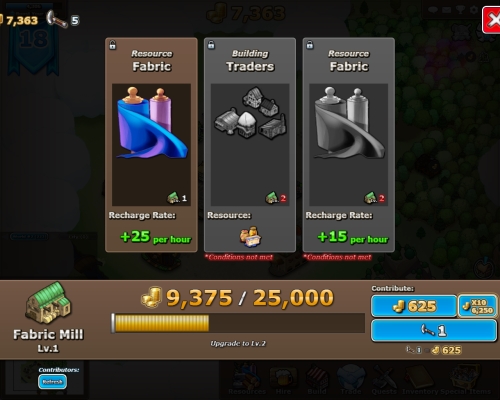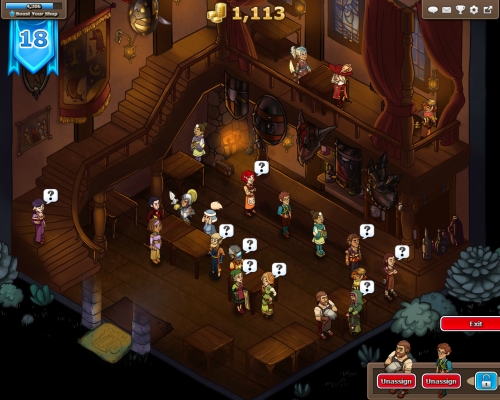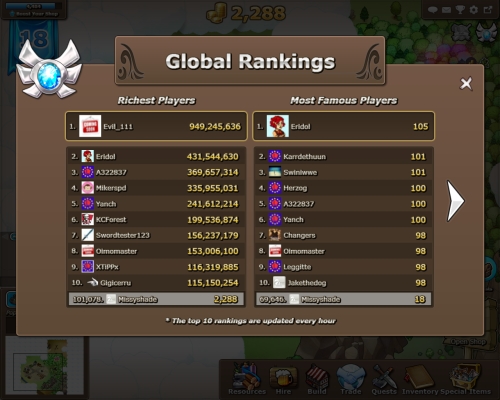Swords & Potions 2 Review: So You Think You Can Sell?

By Jaime Skelton (MissyS)
In fantasy worlds – despite what some MMOs might have us believe about ourselves – not everyone can be the hero dashing off to do good deeds in dark places. Someone has to be the blacksmith, the innkeeper, the stableboy, and of course – a hero’s most for granted but loved citizen – the shopkeep. Sure, you might have dreams of lopping off the heads of dragons, but some have humbler dreams – dreams of stacking gold piles upon gold piles as they sell you equipment for your next great adventure. At least, we presume that’s the premise behind the browser game Swords & Potions 2.
Swords & Potions 2 is midway between your average “run your own shop” Facebook game and the depth of the full-bodied RPG, Recettear. You take on the role of a shopkeeper in a fantasy world, and it’s your responsibility to keep your store stocked with the goods your customers want. This is a multi-layered task, however: you will need to craft items, hire NPCs, expand your shop, go on quests, and gather resources all in an interconnected world. All of this is done in a cycle of active shopkeeping and passive management phases – but first, let’s talk about making loot.
Let The Anvils Ring
Since your customers are adventurers, they’re interested in the same items any RPG hero needs – weapons, armor, accessories, and consumables that will ensure their victory in the next battle. Unfortunately for your shopkeeper, there is no wholesale catalogue to buy these items from: they’ll have to be crafted in your shop. Your shopkeeper will begin with a few basic items, and can craft these items using the resources they have available. While you begin with a few basic recipes, you can unlock more by diligently crafting items (for instance, crafting 12 Healing Herbs will unlock the Antidote) and then completing the item’s research.
Your shopkeeper isn’t the only one in the city capable of crafting, however: as you level up, you’ll soon gain access to additional crafters such as the Blacksmith, Tailor, and Druid. These tradespeople cost a one-time contract fee to hire, but will work in your shop afterward whenever you need them. You will be limited, however, to only a few workers in your shop at one time (at most, three workers plus your shopkeep). Thankfully, you can swap your workers between each active shop cycle, and rotating them every day or two ensures a balanced use of materials and a full inventory of goods.
Interior Design For Beginning Brokers
Your workers can’t create on the floor of your shop, of course, and so you must also manage your shop by building workstations, resource bins, and more. Workstations are the core hub for each of your workers, and where they will craft and research. Each worker has a single preferred workstation, and some overlap, so you must be careful to not bring in two conflicting workers (unless you build two stations – but that’s expensive and we don’t recommend it.) Workstations will also need to be upgraded in order for your workers to create higher levels of recipes.
Additionally, your workers need resources to make items, from simple ore and wood to rarer items like dyes and gems. How you get these items appears to be a mystery at first (we’ll break into it just a little later ourselves), but the key thing starting off is to have resource bins, where these resources can collect and wait for your workers. Your resource bins will determine the maximum number of resources you can have on hand, so it’s important to have multiple and upgrade them often as your recipes become more costly to create.
Your shop also has other things you can create. A mandatory item, of course, will be your counter, where customers will walk up to purchase items. There are also item chests, decorative items, and equipment racks. All of these items offer some sort of bonus to your shop (even the plants!), and can be upgraded for better benefits. You’ll definitely want to build some of these to increase your shop appeal, the chance you can double the items you’re creating, and money and experience gains. Space is at a premium, however, so you’ll also have to shell out a good bit of cash to expand your shop to fit everything in.
A Fool and His Money . . . Make You Rich
So who are you selling to, anyway? Each customer is a permanent resident of your town, and has their own experience level and reputation with your shop. Adventurers come in different classes, with Evokers, Archers, and Guards being just a few you’ll encounter. Each class, like you’d find in an MMORPG, has specific types of equipment they can use; they’re also restricted by their own level as to what equipment they can buy. While the art is shared between each class, each NPC has a different color of garb to identify them as they walk into your shop. In order to do well, you’ll want to keep each NPC as happy as possible, not only by selling them items successfully (even when you’re out of stock of what they want) but also by buying loot from them and sending them on quests.
Out of Stock, Not Out of Fetch Quests
Quests are a staple of any RPG, and your adventurers are itching to be of help. Visiting town NPCs will occasionally arrive and grant you one of two types of quests: event quests and dungeon quests. Event quests are one time quests with a substantial reward (and a long completion time). These quests require you to recruit certain adventurer classes and supply specific pieces of equipment before they begin, but grant rare items (including cash shop items) on their completion.
Dungeon quests, on the other hand, are both shorter and repeatable. These quests allow you to send any visiting adventurer away to return with some gold for you and some gained experience for them (yes, your visiting adventurers have levels too!). Each quest has a level range and three possible rewards, some of which are necessary for crafting. You can also equip your adventurer with loaned equipment to improve their chances at completing the quest, but be warned: this equipment may return to you broken. Equipping is a must to earn fair rewards, so be careful and watch break chances when loaning out to your customers.
Who Runs This Place?
All of this makes for a fine single player experience, but we wouldn’t be here without multi-player. We’ve talked about resources and adventurers, but these things are fueled by the city your shop is in, and that’s also where the game opens up to its multi-player possibilities.
Each city – public and private- has its own development levels, akin to a real time strategy MMO. When you first start in Swords & Potions 2, you’ll be assigned to a random public city, which have no leaders and are managed completely by the server. Thankfully, you can move cities to more populated or developed public cities. You can also create or join a private city, which is managed by a player who can choose who to invite or kick out at any time. Many players spend their early levels reaping the benefits of a populated public city before requesting (or creating) a private city – and for good reason.
Private cities start with a few basic buildings, all at level one. Like everything else in the game, buildings may be upgraded for better benefits and to unlock new features, customers, and resources. Buildings typically offer resources (determining what resources are available, and how many are generated per hour for each player) or additional customers. Upgrades usually cost money or crafted items, although there are also buildings that upgrade by completing special city quests to send specific NPCs to train. The catch is that building upgrades are matters of public works: all players in the city are responsible for donating to public projects to help expand the city for everyone’s benefit. Because of this social pressure (you’re even graded on it!), many players opt for private cities where there is greater expectation and organization, and less room for moochers. Public cities, however, offer a less stressful situation for players who are more casual and don’t want to have to worry about getting kicked out for not contributing enough.
Cities also offer one additional bonus: trading. Players may freely trade in their own city’s market of items, making it easier for players to get items they need for event quests or just to keep their shops stocked. A world-based market is also available, but requires a cash shop item to access, and that item lasts only one hour once activated. This is rather frustrating and disappointing for players running private cities, particularly those with small cities.
How To Win Loot And Influence Adventurers
If it hasn’t become obvious yet, Swords & Potions 2 is actually a rather multi-layered game despite its surface simplicity. You’ll alternate between a short “active” phase in which your shop runs from dawn till dusk, and in this phase, it’s all about crafting and responding to customer requests. In the beginning, these requests are pretty straightforward: sell the item, send away a happy customer. But as you unlock more customers, more workers, and more recipes, the shop phase can become frenzied – at level 20, for instance, I’ve found it impossible to keep one of every item I can craft in stock. When an item isn’t in stock, you have a few options: you can refuse the customer (the worst option), suggest a different item (your chance of success is based on the customer’s happiness), or better yet, kick the customer out of your shop by sending them on a quest. Quests are limited, however, since you can only have a few active at any time, and you can’t send customers on multiple quests. This means that fairly early on, you’re balancing dozens of customers by juggling inventory and active quests, possibly even just taking a break from the game to let some of the quests finish before you anger all your visitors.
On top of that, you must also balance your resources carefully to take care of your city and shop. In order to expand and sell better items, you must upgrade your shop, which takes a nice chunk of your profits. You’ll also need to save up for the more expensive worker contracts as your customers start demanding new items. But your city also needs you, and public works projects aren’t cheap! This is why many private cities prefer that players stay in public cities until they reach level 20 or 30 – this gives the player a better chance to get a head start on improving their shop before they must split their resources for the good of the city. If you want a hard mode style challenge, you can take it upon yourself to create a new city near the start of your career like I did, invite only a few friends, and find yourself fully immersed from the start in the balance of personal gain and the greater good.
What’s Hiding Under The Counter
The downside to all of this is that the whole ordeal can end up feeling like “busy work.” Sure, there are achievements, and you’ll inevitably become a little familiar with your fellow shopkeepers in your city. Kongregate’s chat rooms are also overflowing and rather friendly, making a nice little community of money-minded merchants. But what’s the ultimate goal? Prestige, really: there are multiple leaderboards, including city leaderboards, to be able to boast the best shops and cities globally. Beyond that, there isn’t much ‘end game,’ other than the tease of an icon that promises opt-in PvP called City Wars soon.
That said, the ‘end game’ – having everything finished, researched, and a fully built city – is also many, many long weeks from your starting point. Any game can be worn down to its base mechanics and seen as a grind, and ultimately the question you’re going to have to ask yourself is: is it fun for me? Since I’m the kind of player who loves to crunch into the numbers of player economies, who seeks creative methods for profit, and who can’t help but get sucked even into Facebook shop simulators from time to time, Swords & Potions 2 has become absolutely addictive. Because of its game design, I can also play it in casual five-ten minute break times, or spend a few focused hours working on my mercantile empire. It’s certainly a breath of fresh air when it comes to browser strategy RPGs, which often fail in heavy reliance on cash shops or in lackluster communities.
However, Swords & Potions 2 also lacks a final “oomph” factor to it to really drive players to compete with each other, to customize their shops or character, and to stick it through all the way to the pricey end. To that end, it’s a little like Cookie Clicker: when you’re in, you’re in good, but when you’re done, there’s just not much to do but pat yourself on the back for time well wasted.
Final Verdict: Good
Articles You May Enjoy
- Bigpoint and Fox team up for Ice Age Online
- Bigpoint announced today they are teaming up with Fox Consumer Products to bring players Ice Age Online.
- Novus AEterno: New Update on Economics and Syndicates
- Taitale Studios has just released a news update for their crowdfunded MMORTS title Novus AEterno, with new details regarding the game's e...
- Netmarble Confirms New Name, Evilbane, for Anticipated Mobile ARPG
- The action RPG known as 'Raven' in South Korea will arrive for the worldwide market on iOS and Android later this year as Evilbane.
Videos You May Enjoy
-
ivan


















